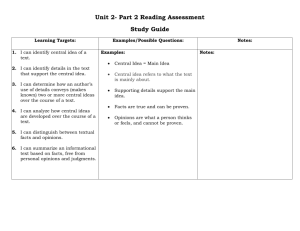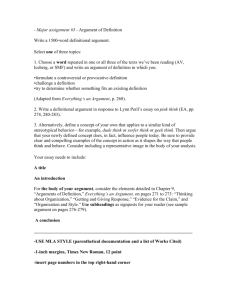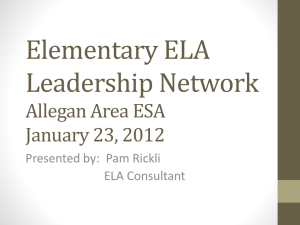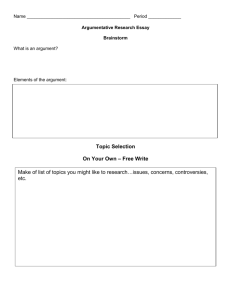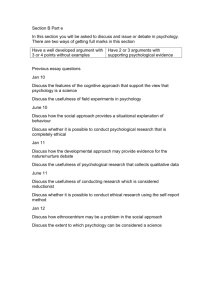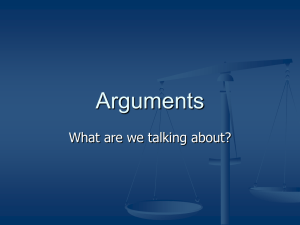Teaching Argument - mscodysclass
advertisement
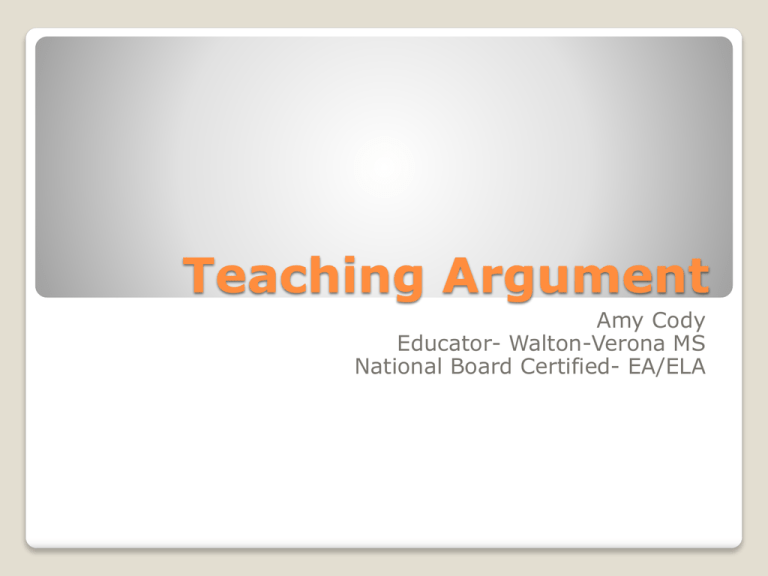
Teaching Argument Amy Cody Educator- Walton-Verona MS National Board Certified- EA/ELA The new Common Core State Standards focus on close reading and evidencebased argumentation as the key to academic literacy, career readiness, and rigorous thought. The Standards The Parts of an Argument claim • Answers a specific question given in a prompt or asserts an independent claim generated by the student. • Claim statement often suggests/addresses an audience. • Tells readers why the issue is significant*. Providing key words as part of an essential question unit often helps students express this significance and their reasoning. For example, in discussions of Facebook and teens, “privacy,” “freedom,” and “safety” are key terms students will need. *CCSS Strategy- Practice Close reading of various articles with controversial issues presented- Students practice making a claim- agree or disagree and why. - Color-code author’s claim and in a different color the points that support that claim. - - Students can respond to a discussion board- List topics and require response to topic as well as response to another student. www.wallwisher.com- Students can post their claim on this space for practice and discussion. www.polleverywhere.com- student can agree or disagree- works toward making a claim on an issue. Claim- Technology Discussion Board Wall Wisher http://wallwisher.com/wall/v5a5 klienh Poll Everywhere- Easy and Quick! evidence • Quotations from the text (Word for Word). • Summary of text. • Paraphrased information. • Facts & statistics. • Anyone engaged in the argument can find this and use it. StrategySentence Frames- use to respond to close readings/articles that present controversial issues. ACE- Answer, Cite, Explain (or elaborate) See handout- Example Starters for Citing Evidence reasoning • The source of the greatest language and cognitive demands. • This is thinking spelled out. • Answers this question: “How does that evidence help prove the claim?” • Where rigor and learning reside. Strategy: ACE Sentence Starters • Bring it on! The counter-claim challenges students to consider other viewpoints by asking them to state an opponent’s argument and to develop a rebuttal from a shared value. • Exploring opposing viewpoints is a strong thread throughout all academic standards, from the College Readiness Standards to the Common Core Standards. It is also a skill featured prominently in Advanced Placement assessments across disciplines. Counter-Claim Students use Sentence Frames to counter-argue. ◦ Some argue________ ; however, ______. ◦ See Sentence frames handouts Students practice counter-claims in isolation from an entire piece. Discussion- Students choose sides and debate Counter-Claim- Strategies 6 Box organizer- simple to use/remember Argument Outline Intro- specific topic + debatable view + significance to the audience Body- points to argument/Counterargument Conclusion- What are the benefits of accepting my argument? See Epals Argument Writing Graphic Organizer handout. Graphic Organizers Students need practice in a timed atmosphere. ◦ I do many pre-writes with students using 6 boxthey have less than 10 minutes to complete the parts needed. ◦ I time them in creating introductions and counterarguments so they can think on their feet. ◦ Students get practice in class and as a whole school (8 grade) we do two scrimmages a year with teachers available in a Live Scoring Atmosphere. Timing Samples created MS vs. High school (MS- 1/HS can be 2) Finding articles to use. ◦ Kelly Gallagher Article of the Week ◦ Newspaper/Online news ◦ Procon.org Passage Based Prompts The order in which I teach Argument- See handouts More Resources available at: http://mscodysclass.wikispaces. com/Argumentative+Resources MORE RESOURCES!

